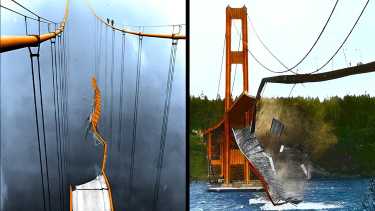You Wouldn't Survive Dipping Your Toe In This Lake
Find out the tragic reason you wouldn't survive dipping your toe in this lake!
KnowledgeOver in the vast central reaches of Russia, in a region below the South Ural Mountains, is a place Russia wishes had never existed. There used to be a lake here, which, at its largest, measured in at 110 acres, about the same as 83 football fields. Although, it wasn’t the sheer size, or even depth, of this lake that made it a living nightmare but what was in it. Let's investigate the terrifying true tale of Lake Karachay.
Lake Karachay
Back in 1945, the first nuclear bomb was used as a weapon during the Second World War. It was dropped by Americans on Hiroshima, Japan, leveling 5 square miles of the city, and killing up to 180,000 people.
Tens of thousands perished immediately, and the effects of deadly radiation in the days and months that followed claimed around 100,000 more. It was the single most devastating weapon that had ever been developed, and it caught the eyes of leaders around the world.

One of those was Stalin, the then leader of the Soviet Union. Determined to compete with the US, he ordered the development of a series of top-secret nuclear facilities in a location hidden from enemy eyes. These would be dedicated to producing the materials needed to create nuclear weapons.
He settled on a region of central Russia, below the South Ural Mountains, which was far enough from the boarders and other inhabited areas to keep the project hidden from the rest of the world. Between 1945 and 1948, the Mayak nuclear facility was erected on the shores of Lake Kyzyltash in total secrecy.
Over 70,000 prisoners of war from 12 gulag labor camps were forced to construct the enormous facility. They were also used to build a city nearby which would be the home to 10,000 employees of the new plants, along with their families.
This was roughly 60 miles from the closest city of Chelyabinsk, and so it was known simply by the last digits of its postal code; Chelyabinsk-40, or City 40. The government promised it’s citizens they’d never want for anything and would have a great standard of living.
Sounds like the dream, except the city, and all the plans around it, had to be kept secret. Anyone who refused this offer was sent straight to the gulags, as they’d been exposed to sensitive security information. So it wasn’t like they had much of a choice!
The gates of City 40 were guarded day and night, it was surrounded by fences and walls topped with barbed wire, and it wasn’t marked on any Soviet Union maps.
Unless citizens were granted special permission by the government, nobody was allowed to enter or leave City 40. That’s because, almost as soon as Mayak and its city were complete, it began producing weapons-grade plutonium, something they really didn’t want the rest of the world to know.
By 1949, the Soviets had their hands on their first plutonium bomb, which was called First Lightning. The success fueled them to make even more atomic weapons, with around 44 cities similar to City 40, colloquially called Closed Cities, established around the Soviet Union.
Some of the facilities attached to these housed all manner of nuclear research efforts, from plutonium production to uranium enrichment.
But the Soviets weren’t the inventors of the first closed cities. That idea came from the US’s Richland City, which was secretively built around the Hanford nuclear plant; the same plant that supplied the plutonium for the bomb dropped on Hiroshima!
Soviet spy circles had intercepted plans for the city, with Stalin deciding to use this information to follow in the US’s footsteps.
Although that wasn’t the only secret they stole. The majority of the Soviet’s nuclear research had been stolen by Atom Spies involved in the Manhattan Project, the mission that developed that first nuclear bomb. But they hadn’t managed to get their hands on everything. This meant there were huge holes in the Soviet’s knowledge of nuclear physics.
Combined with the pressure to save money, plant leaders were forced to cut a lot of corners regarding worker training, safety, and radiation monitoring.
Workers were rarely properly protected, pollution was an afterthought, and, horrendously, workers would clean up radioactive spills with their bare hands. They would only stop working when blood started pouring from their noses, a side effect of their bodies being broken down by lethal amounts of radiation.
But that was the least of their problems. The 7 main reactors of Mayak utilized open cycle-water cooling systems to prevent the reactors from overheating. Here, water was pumped in from Lake Kyzyltash and the nearby Techa River, and into the reactor core itself.
Then, without being processed or decontaminated, the water was pumped back into these same water sources. This meant millions of gallons of irradiated water was being dumped into the water the inhabitants of City 40 drank from and bathed in.
And not just City 40, villages along the Techa also relied on the river as their main water source, meaning a further 28,000 people were unknowingly reliant upon lethally tainted water sources.
None of them knew they were living in a dangerously radioactive area. But this was just the start of Mayak’s problems. In their bid to get plutonium production up and running as quickly as possible, they hadn’t considered the extensive requirements needed to store all the radioactive waste products.
In the first three years of operation, this was basically non-existent, and workers would simply dilute high level waste and dump it into the Techa River. By 1951, after it was clear this was causing huge amounts of environmental damage, they decided it was safer to dump all the waste in a stagnant body of water, Lake Karachay.
It wasn’t until 1953, 5 years after Mayak opened, that they began storing high level waste in stainless steel tanks. Altogether, these 20 tanks could hold up to 1,600,000 gallons, more than 2 full Olympic swimming pools worth of radioactive waste.
These were buried underground, surrounded in a 5 ft thick concrete casing, and kept cool using an external water-cooling system. All these elements were designed to keep the active waste from overheating. Or at least, they were meant to.
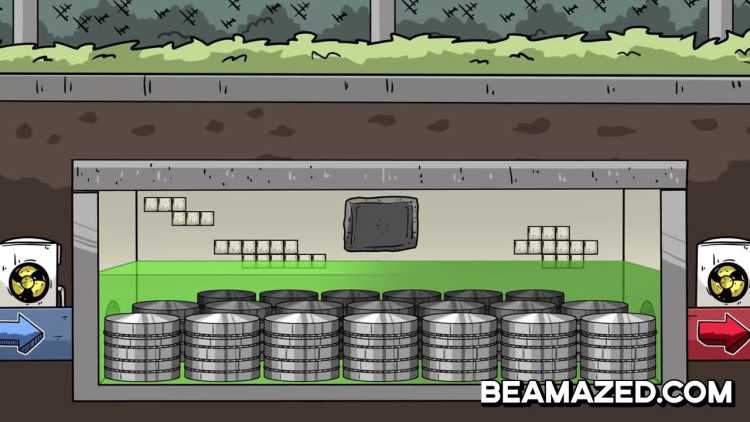
Over time, the instruments for monitoring the tanks failed, but they couldn’t be repaired because the level of radiation in the area was too high. Eventually, the waste in the tanks reached a boiling 662°F, and then on September 29th, 1957, at 4:20 pm, disaster struck.
An explosion with the force of 100 tons of TNT shook Mayak complex. The 5 ft concrete lid covering the tanks was blasted over 80 ft away, and 80 tons of radioactive waste began spewing out at an alarming rate.
It’s estimated this initial blast released a little less than half of the radioactivity measured at the famous Chernobyl explosion, which would occur less than 30 years later.
Fortunately, 90% of the waste was liquid, irradiating only the nearby facility. But the remaining 10% was drawn into a radioactive plume that towered over half a mile high and began drifting northeast.
In 11 hours, the radioactive particles in the plume were detected in Tyumen, a city more than 200 miles away from Mayak. In a matter of days, almost 9000 square miles of land containing 217 towns and villages, with more than 270,000 people, were contaminated with lethal doses of radiation.
This was the Kyshtym Disaster. There are only two other radioactive incidents in history more severe than this: Chernobyl, and Fukushima. As the water supplies became increasingly contaminated from the spill, the government started to panic.
They calculated that three villages downstream from the disaster site, Berdyanish, Saltikovka, and Galikaeva, would receive a huge cumulative dose of radiation inside of a month. At the time, the absorbed amount of radiation was measured in units called rads. Just 5 rads was enough to potentially, and irreversibly, damage a person’s chromosomes.
But the citizens of these villages would receive cumulative radiation doses of up to 300 rads. That meant serious radiation sickness, along with bone marrow and intestinal destruction.
10 days later, these villages, containing roughly 1500 people, were evacuated. The villages themselves were destroyed, incinerated where possible. But the survivors were told nothing.
Fortunately, a follow up study revealed no long-term radiation damage was detected in the survivors. But they weren’t the only ones to lose their homes.
8 months later, a further 6500 people were evacuated from 23 more villages. During this time, they’d consumed contaminated crops, drunk contaminated water, and lived on contaminated lands. But suspiciously, no registry was ever set up to follow their medical histories.
A year after the incident, all pine trees within a 12.5-mile radius of the disaster site had died. Instead of declaring a radioactive disaster, the Soviet government simply covered the incident up. No one would know about the full extent of the Kyshtym disaster for more than 30 years.
But the horror didn’t stop there. The sheer amount of untreated radioactive waste that had been dumped into Lake Karachay meant that, over time, it accumulated 120 million curies of radioactivity. By comparison, the Chernobyl disaster released approximately 185 million curies of radioactivity in total.
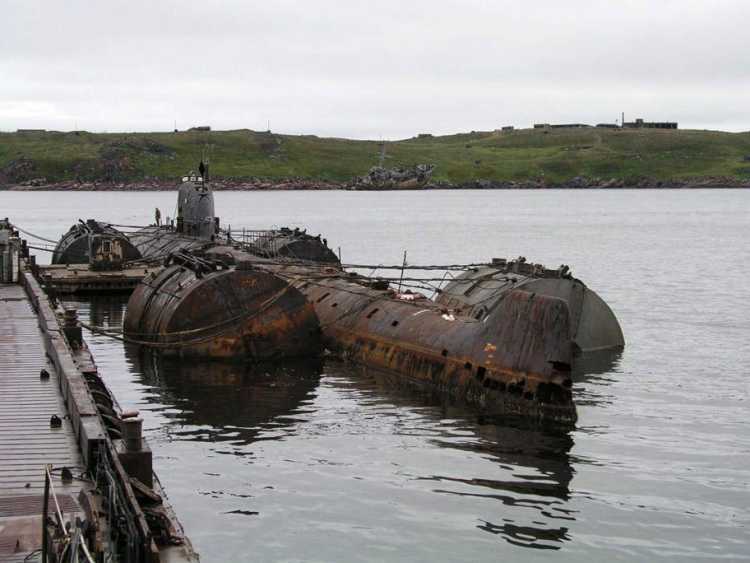
However, the radioactive isotope Caesium-137, which is responsible for long term land contamination, was 40 times higher in Lake Karachay than at Chernobyl. That meant the lake, and the area surrounding it, would remain contaminated for much, much longer.
It also meant that if anyone decided to visit the most polluted part of the lake, or just dip their foot in the water, within an hour, they’d receive a lethal radiation dose of more than 500 rads.
You might think this would destroy their foot, maybe see it shrivel up, melt off, or even sprout a few more toes, depending on how you think radiation works!
But actually, this would result in acute radiation sickness. The exposure would begin to destroy all the cells in the entire body, rapidly. After 30 days, there’s a 95% chance you’d be dead.
By 1960, Lake Karachay appeared to be drying up. By 1967, after a hot summer, followed by a dry winter, the remaining water evaporated. This was originally seen as a blessing, but it was actually more of a curse.
It meant all the still-radioactive sediment was contained in the dry dust layering the lakebed. All it would take was a gust of wind to stir this up and create another radioactive incident.
But the region didn’t get a gust of wind. It got a windstorm. The sediment was spread far and wide over the region, dusting the citizens and environment with yet another dose of deadly radiation.
It wasn’t until 1973 that the Soviet Government began the arduous process of filling in the lake with tens of thousands of concrete blocks to prevent any remaining sediment from shifting. It took decades of work, but by 2015, the lake was finally filled in.
You’d think that, during this time, the Soviet Union was doing everything in its power to alert its citizens to the danger and keep them safe. But unbelievably, it wasn’t until 1989, three years after the meltdown at Chernobyl, that information about the events in the Southern Urals was finally declassified.
After the fall of the Soviet Union in 1991, City 40 had its existence formerly acknowledged by the new government and was renamed Ozersk. Descendants of the original population still live there, and today the inhabitants receive everything their government promised them way back in the 40’s.
But now the citizens are aware that their children are more likely to be born with serious health conditions, that their water is contaminated, that many of the beautiful areas surrounding them are no-go zones, and that their average life expectancy is much lower than the rest of the country.
While the story of Lake Karachay and the Kyshtym disaster haunts Russia’s history books, it’s not the only lake in the country known for being impossibly and irreversibly polluted. A little over 26 miles away from Karachay, the town of Karabash still has a lake. Although the water, like a lot of the surrounding land and forests, holds a defiled reddish orange hue.

That’s because back in 1910, Karabash became the site of a copper smelting plant. Over 180 tons of sulfur dioxide and heavy metals were released into the environment from this site each year.
Even though it was eventually shut down in 1989, the area still holds 500 times the normal concentration of heavy metals, like Iron and Copper Oxide, in it. While spending a few hours swimming in this sludge might not have any immediate effects, if you ingested it, the chances are you’d contract heavy metal poisoning.
In the short term, you’d get pretty sick, but long-term residents of the area suffer from higher rates of skin diseases, cancer, strokes, and congenital malformations compared to the rest of the country.
So, obviously Russia is home to some pretty dangerous bodies of water. But nuclear contamination and pollution aside, there are even more, even deadlier lakes all around the world.
Kawah Ijen
There’s nothing more inviting than beautiful turquoise waters. There's a lake in East Java, Indonesia, that looks like a private pool on top of a mountain. Anyone would want to swim in it, but its water looks suspiciously too turquoise. What went wrong there?
The pool is located in the active volcanic crater of Kawah Ijen, in Java. It’s turquoise coloring comes from the range of materials dissolved in the water, including hydrochloric and sulfuric acids produced by the volcanic activity below.
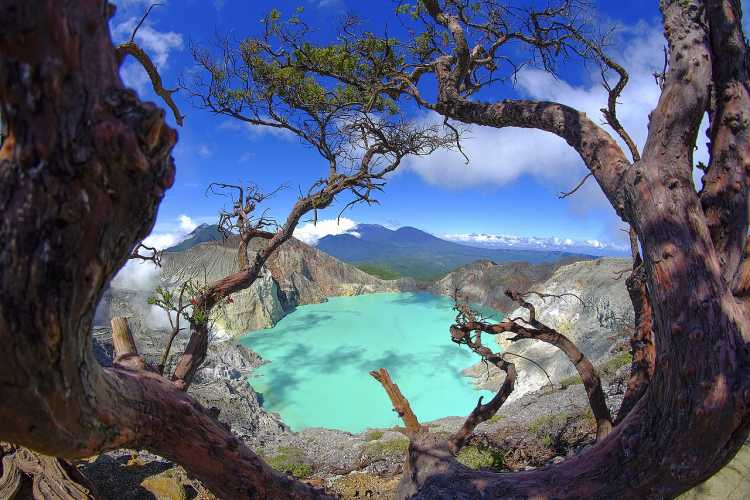
Not only does this make the water look gorgeous, but it also gives it a pH of 0.3. For those who don’t speak science, neutral elements, like water, have a pH of around 7. Stomach acid has a pH of 1. So, this stuff is straight up corrosive!
So much so that if you were to dip your foot into this pool, even briefly, there’s a chance you’d come out with chemical burns depending on how far the solution penetrated your skin. It could cause red, irritated skin, blistering, and even scarring.
But if you were to take a full body dip, and stay in there for as long as possible, your entire body, even your teeth, would dissolve in roughly 15 hours.
Blue Lagoon
Naturally inviting turquoise waters aren’t just found in the craters of active volcanoes! Over in the UK, another deceptively beautiful lake can be found in a pit dug into the Derbyshire countryside.
The lake is called the Blue Lagoon. In 2013, and again in 2020, the local council dyed the brilliant blue waters black to try and dissuade eager swimmers from stepping foot in it because the water is toxic.
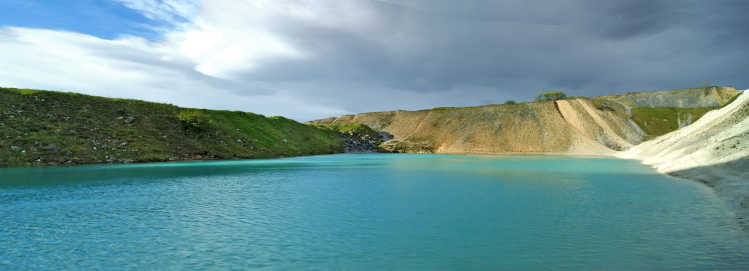
It’s actually situated in an old limestone quarry, which, after it was disused in 1952, was used by the Royal Air Force to store chemical weapons until 1960. Eventually, it was emptied out and left to gather rainwater.
But the water turned turquoise, as limestone rocks leached calcite crystals into the water, giving the lake a pH of 11.3. Considering ammonia has a pH of 11.5, and bleach is about 12, going anywhere near the water in this lagoon is a horrible idea.
Despite signs warning about skin irritation, stomach problems, and even rashes, it wasn’t enough to stop people from being drawn in during lockdown! Not even all the dead animals and trash that have found their way into these deadly waters over the years was enough to keep them away.
Berkeley Pit
The horizon of Butte, Montana, looks like any other city until you clock the gigantic, 1 mile long, and half mile wide pit gouged into the landscape! It's the 1,780-foot-deep Berkeley Pit that's filled with ominous black and red liquid.

It's an open pit copper mine dug back in the 1950’s, where it produced nearly 17,000 tons of copper a day. However, it was closed in 1982 after its profitability plummeted. They shut off the pumps keeping the ground water at bay, and the pit began to flood.
But the water that filled it up was laden with chemicals and metals leeched from the rock, like arsenic, cadmium, zinc, and sulphuric acid, giving it that devilish color, and then some.
In 1995, a flock of 342 snow geese were found dead in its waters. They’d been resting in the lake to avoid a squall, but little did they know the lake had a pH of 2.5, meaning it was acidic! While it was only about as acidic as substances like lemon juice, the poor birds were found with burn sores all over their bodies!

Montana has since begun water treatment efforts to pump and treat the pit. But still, while it wouldn’t kill you, stepping foot in something with that kind of history can’t be good for you.
Grand Prismatic Spring
Not all deadly bodies of water look so ominous if the Grand Prismatic Spring of Yellowstone National Park is anything to go by! Found in the Midway Geyser basin, this is the third largest natural hot spring in the world at 370 ft in diameter, making it bigger than an entire football field!
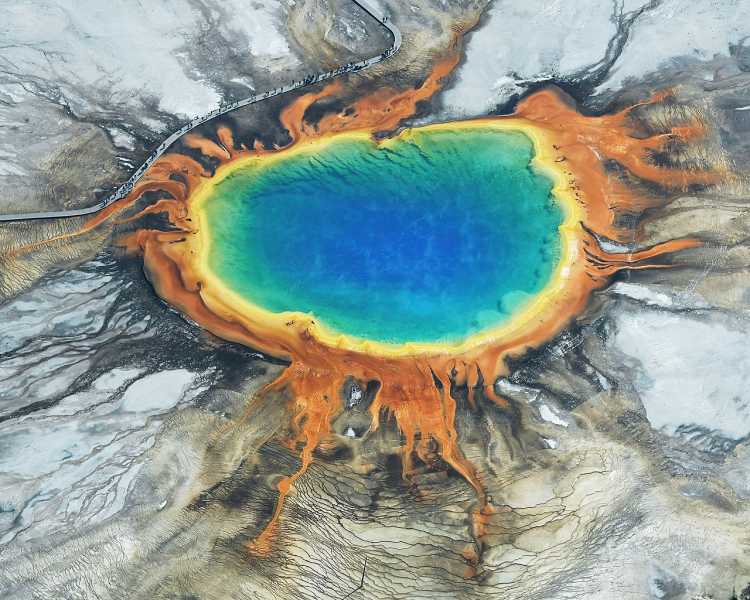
The incredible concentric circles of vibrant blues, greens, yellows, and oranges make it look like someone has painted a target onto the bedrock beneath. But the color actually comes from heat-loving bacteria.
As the geothermally heated water erupts from the center of the spring, it reaches a spicy 189°F. When it spreads out, the water cools, allowing rings of different bacteria that thrive at different temperatures ranging from 131 to 189°F. That’s pretty hot, so hot that if you were to put your foot into the center of the circle for just a few seconds, you’d be left with third degree burns.
Though it could always be worse. Back in 2016, a young man named Colin Scott slipped and fell into a nearby geyser and was boiled alive. That’s horrifying, but what made it even worse was that the water here is also slightly acidic, and combined with the intense heat, the poor man’s body dissolved overnight. No trace of him was ever found.
So, if ever you visit this hotspot, be sure to stay well away from its colorful edges.
Rio Tinto
Snaking over the Spanish countryside is a river that looks more like a forbidden gummy worm than water! It's called Rio Tinto, a name that helpfully translates to ‘The Stained River’. At more than 62 miles in length, roughly half of the river is colored red, orange, and yellow.
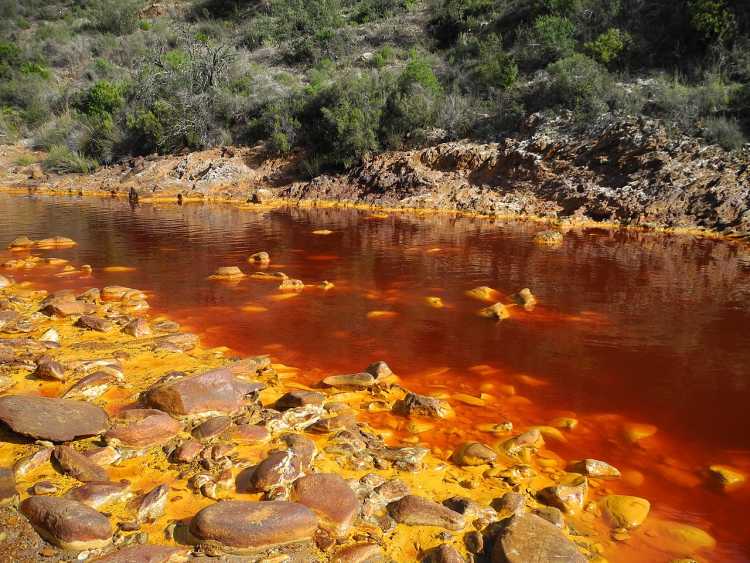
That’s because it flows through an area that’s rich with sulfur ore deposits, which formed hundreds of millions of years ago when there were active volcanoes in the area. Thousands of years of mining have also amplified the process, increasing the amount of exposed ore.
This has made the river incredibly acidic, meaning the only thing that can live in the water is sulfur consuming bacteria. As they consume the sulfur, they produce ferric iron, a rust-colored substance that gives the river its red hues.
Together, the ore deposits and bacteria drop the pH level of the water as low as 1.5, meaning this river is more like vinegar than water!
Dipping your foot in this wouldn’t cause any initial damage but leaving it in for an extended period would result in irritation and redness. That doesn’t sound too bad, but you should still not go splashing about in it!
Lake Natron
Tanzania is famous for its stunning Serengeti National Park. But surprisingly, it’s less well known for the 490 square mile body of water on its northern border, that has the power to turn living things to stone. It may sound like something out of Greek mythology, but it’s all real.
Lake Natron is in an area so hot that it loses most of its water to evaporation, leaving the salty, mineral rich remnants to crust over the surface like big red scabs.
The water that remains is so saturated with salt that most birds flying over, hoping for a quick dip, suddenly find themselves coated in salt crystals! These fatally calcify and trap the poor creatures in a matter of minutes.

And that’s not all. The sodium and mineral rich bedrock make the environment strongly alkaline, meaning the remaining water has a pH of 10 on a mild day, and a pH of 12 when the waters reach a scalding 140°F.
So, at its best, taking a dip in this lake would be like wading through salty milk of magnesia. But at it’s worse, it’d be like swimming through boiling hot bleach.
While it wouldn’t burn you immediately, keeping it on your skin would give you an alkaline burn, these are often worse than acid burns, as alkaline chemicals can penetrate and damage deeper layers of tissue.
Something a group of very unlucky wildlife photographers almost learned the hard way back in 2007. As they were flying over the lake, their helicopter crashed into the water! The hot water immediately began burning their eyes and practically blinded them.
But they miraculously managed to travel around 2 miles to the nearest solid ground. Fortunately, they all recovered, but any longer in there and it might have been a very different story.
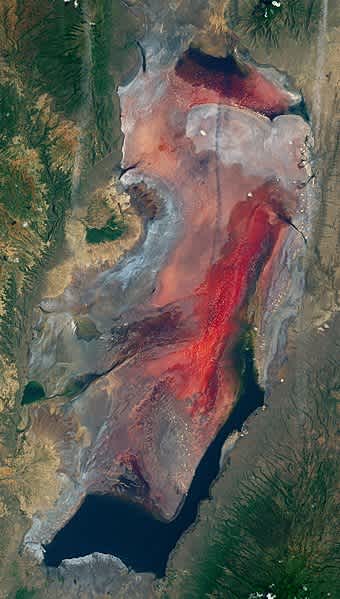
Boiling Lake
Fumaroles are openings in the planets crust which emit superheated steam and gases. But when a fumarole gets flooded, that’s when you get something like the Boiling Lake in Dominica.
At roughly 250 ft wide, this bubbling water is usually enveloped in an ever-present vapor cloud. That’s because the water here fluctuates between a spicy 180 and 197°F.
[EMBED [POST](https://www.youtube.com/watch?v=3bsQmrGp4Hw)
Although, that’s just the temperature at the edges, scientists haven’t been able to measure the temperature at the center where the lake is actively boiling, because it’s simply too hot for them to handle!
It’s believed this lake lies just above the local water table, which is the natural boundary between the dry soil and the saturated soil of the earth. This is what keeps the lake from drying up entirely, even though much of its water is lost to evaporation.
It’s pretty obvious that sticking any part of your body in this is a bad idea, that’s a second, maybe even third degree burn just waiting to happen! But it’s not the only reason why this lake is one of the most dangerous in the world.
Way back in 1900, a group of hikers were clambering around the area when all of a sudden, the lake released a cloud of toxic volcanic gasses! They didn’t stand a chance, and sadly didn’t survive.
So, if you decide to visit this lake, don’t just bring your water wings, you’re going to need a gas mask as well!
If you were amazed at these toxic lakes, you might want to read this article about places you should never swim! Thanks for reading.






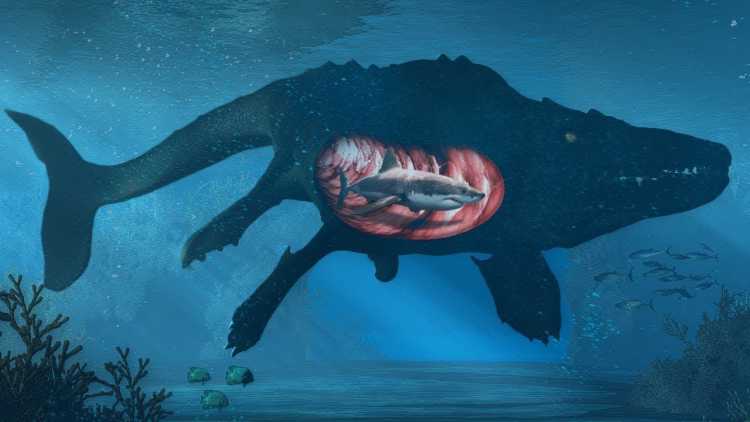




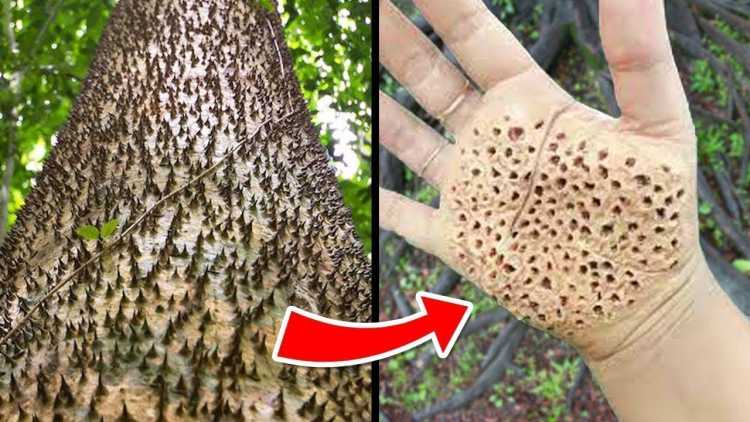

![Embarrassingly Dumb Ways People Died - Darwin Awards Winners [Part 14]](http://images.ctfassets.net/l031eph9pzsg/686De1sLP59fCNWLkbDwm5/4031ad820164610867ececf9513ce5ce/embarrassingly-dumb-ways-people-died---darwin-awards-winners-_part-14_.jpg?w=750&h=422&fl=progressive&q=50&fm=jpg)








